Collaboration_with_Kerberos#
Introduction#
This page is not an RFE. It is intended to be an informative companion to External Users in IPA by articulating the processes by which external users obtain credentials for the local realm. The use case supported by these mechanisms is described on External Collaboration Domains. In summary, the external collaboration domain is expected to host web services, console login services, and file sharing services, but has few or no locally defined users.
Three primary mechanisms are articulated:
Kerberos cross realm trusts. (Includes vanilla Kerberos trusts, trusts to IPA, and trusts to AD)
Kerberos PKINIT operation
Leveraging Non-Kerberos identity technologies
The third mechanism introduces the need for a gateway server to interact with the non-Kerberos technologies, adapt foreign identities into the Kerberos name@realm pattern, and to provide a means for the user to obtain Kerberos credentials from the KDC.
External Users in IPA articulates a need to create a reference to external users in the local LDAP store in order to coordinate and serve POSIX attributes for these users to the hosts in the local realm. For each mechanism by which external users may enter the local realm, this page identifies how external users are detected.
Mechanisms#
Background#
This section develops a visual vocabulary to help articulate Kerberos message flows. The iconography introduced here will be leveraged throughout the remainder of the page. This starts out very basic, but it is necessary later on when cross-realm operation is considered.
The first element to introduce is the Kerberos ticket. This is how clients are authenticated to services and vice versa. As shown below, a ticket has two parts: a “client” and a “service”. These separately share a secret with the Kerberos server. They do not share a secret with each other (e.g., the service does not know the client’s password.) This property makes Kerberos a “Trusted Third Party” system. The top half of the illustration shows that the ticket encodes a “name” and a “realm” for both the client and the service. In the simplest case, such as when a user is accessing a service in their home realm, the realm for the client and the server are the same.
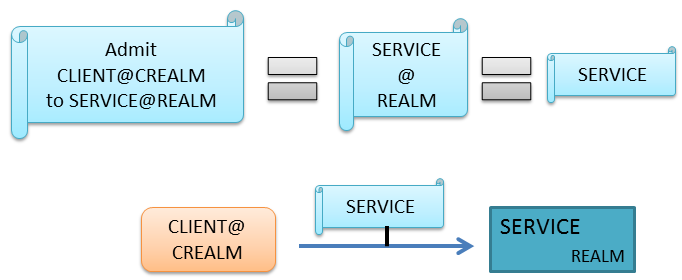
KrbTickets.png#
In this visual language, displaying the “client” information inside the ticket may be redundant. If a ticket is shown participating in an interaction between a client and a server (as in the bottom part of the above illustration), the client part is generally omitted. Additionally, if the realm is or should be clear from context, it is also omitted. If the realm is shown, it applies to the service.
A user begins their interaction with Kerberos services by providing
proof of identity to the Kerberos Authentication Service (AS). If the AS
accepts the user’s identity, it returns a ticket good for admission to
the “Ticket Granting Service” (TGS), typically called a
Ticket-Granting-Ticket (TGT). The Kerberos specification reserves names
beginning with krbtgt for these special ticket granting tickets. If
a user successfully authenticates to the AS and receives a TGT, they
store it in the cache (step 3 below). The AS and the TGS are typically
hosted on the same physical machine and are collectively known as the
Key Distribution Center (KDC).

KrbAS.png#
Once a user has a TGT in their ticket cache, they may use it, as shown below, to obtain service tickets. This is the basis of Kerberos Single Sign On (SSO), as the user needs only provide proof of their identity once, at the beginning of the session. As long as the user’s TGT has not expired, they may obtain tickets for whatever service within the realm they require. This is depicted in the illustration below for the simplest case, where the user and the service are in the same realm (CREALM). The realm is displayed on the ticket in this case to stress the fact that the TGT being used is correctly being applied to the specific TGS for which it was issued. This may seem pedantic, but cross realm operation opens the door to more than one KDC, and it becomes important to keep track.
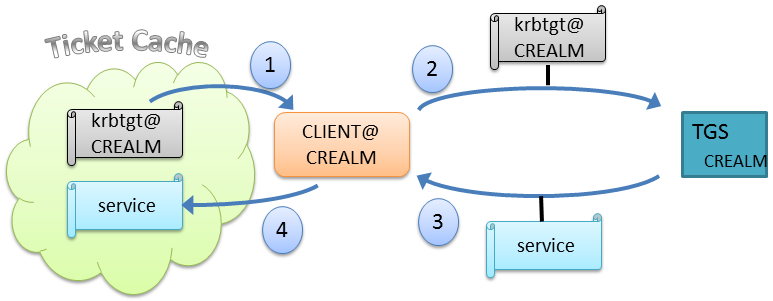
KrbTGS.png#
Note: all applications connected to your control session can share the
same ticket cache. This is generally what you want. Fire up a browser,
and it should be able to log you in to a kerberized website. Ssh to your
machine, it should know who you are. Generally, this sharing does not
lead to substantial savings in network traffic, as you can’t ssh to
a website or point your browser at sshd. However, it does mean that
all your client apps are looking through a common cache for a TGT they
can use, which allows all your apps to take advantage of SSO.
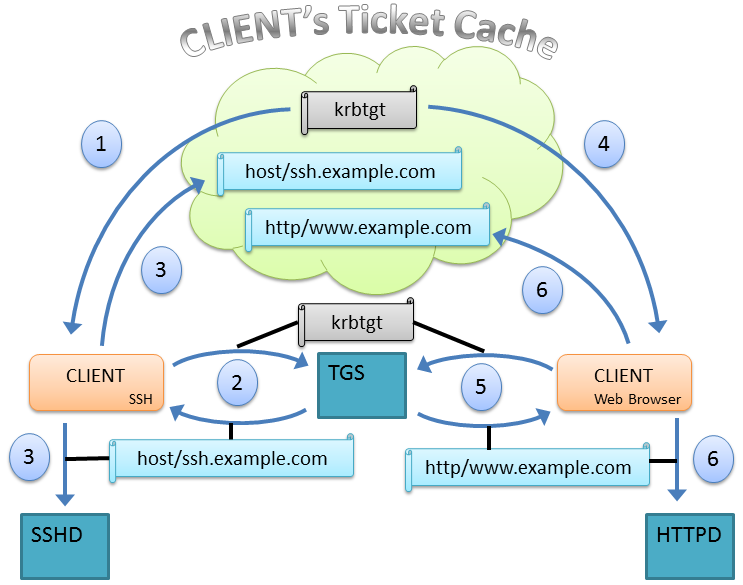
KrbTicketCache.png#
Mechanism 1: Kerberos cross-realm trusts#
Kerberos SSO may work across realms, if the realm administrators have
cooperated to make it do so. The mechanism by which this is accomplished
is known as a cross-realm ticket granting ticket. In the picture below,
this is the ticket for the principal named krbtgt/CREALM issued by
REALM. The name has a special form: the text after the slash
indicates the realm to which the cross realm TGT was issued. The ticket
is to be used to obtain service tickets for services in REALM (not
CREALM). Both realms must have a principal with this same name in order
to make cross-realm operation work.
This is known as a one-way trust, and it allows users from CREALM to
authenticate to services in REALM. It does not allow users from REALM to
access services in CREALM. If a two-way trust is desired, a second one
way trust (in the opposite direction) must be established. The principal
name for the complementary trust in this case is krbtgt/REALM, and
it would be issued by CREALM.
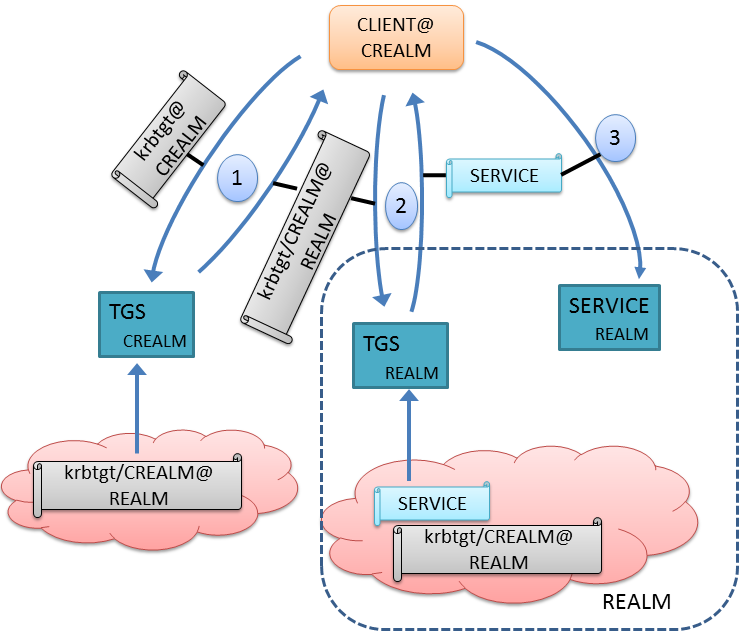
KrbCrossRealm.png#
The above figure illustrates how native Kerberos cross realm operation works. The client must walk the “authentication path” composed of cross-realm trusts. Starting in its own realm, CREALM, at step 1, it obtains a cross-realm TGT for REALM. It then contacts the TGS for REALM using this cross realm TGT at step 2 and requests a service ticket for the desired service. In step 3, the client contacts the desired service using the freshly minted service ticket. The picture above represents the simplest case of a one-hop authentication path. More hops are possible.
It is important to note that the client’s identity is always CLIENT@CREALM. This is not a conflict with the identity CLIENT@REALM. No account is provisioned in the local realm, and the user’s password is not shared between realms. This is not the same thing as creating an account for CLIENT in the local realm, as a new password would be demanded and the client’s identity would change to CLIENT@REALM upon login.
Note that the first interaction of a particular external user with the local IPA realm is with the Kerberos TGS server. For this mechanism, it is possible to monitor all interaction of external users with the local domain’s services by auditing the presentation of cross realm tickets to the local TGS, noting the name and realm of the user who presented it, and recording which service was requested.
Mechanism 2: Kerberos PKINIT cross-realm operation#
Native Kerberos cross-realm operation is most commonly used inside a single organization, where the Kerberos realm administrators for all realms involved are either the same people, or are part of the same administrative team. In addition, clients must have the ability to connect to all KDCs along the authentication path from where their user account resides to the realm containing the service they wish to use. KDCs, being high-value targets, are often protected by organizational firewalls, and therefore may only be accessible to clients connected to the organizational intranet. The degree of close coordination and accessibility required by the native Kerberos method is not typically found in an inter-organizational setting.
An official shortcut has been devised which relaxes these coordination and accessibility requirements. “Public Key Cryptography for Initial Authentication in Kerberos (PKINIT)”, or RFC 4556, eliminates the need for administrators to coordinate cross-realm TGTs as well as need for the client to “walk the authentication path.” The client’s first interaction with the local realm, which contains the service to which the client wishes to connect, is to directly contact the local AS.
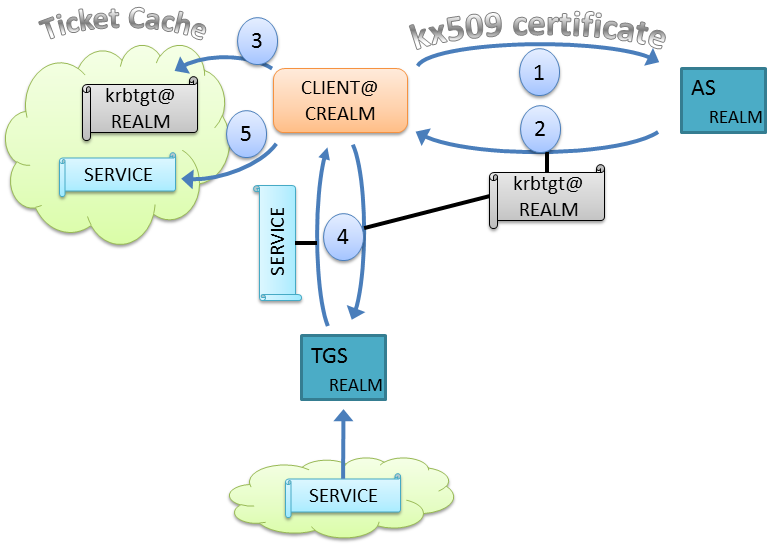
KrbPKINIT.png#
Recall from earlier that the local AS demands that the user provide acceptable proof of identity. In the case of an external user, the local AS does not directly share a secret with the external user (i.e., it does not know the user’s password), so an alternative method must be used. In step one, the client presents a digital certificate with special parameters defined in “kx509 Kerberized Certificate Issuance Protocol in Use in 2012” (RFC 6717). This digital certificate binds the enclosed public key with the user’s Kerberos identity, and also identifies the entity making the assertion. If the AS is configured to trust whomever certified the user’s identity, and the user is able to prove that they hold the private key corresponding to the certified public key, a TGT for the local realm is returned to the user (step 2). This TGT can then be cached by the client (step 3) to obtain service tickets (step 4) within the local realm. The service tickets may also be cached for re-use (step 5).
For this mechanism, monitoring the interaction of external users with the local realm requires auditing any PKINIT-style authentications with the local AS. Also, because this method is designed to relax the requirement for cross-realm coordination, the likelihood of locating the original user attributes in “CREALM” is smaller than for use case 1.
Mechanism 3: Non-Kerberos web Identity Providers#
Perhaps the most ubiquitous source of user identities is the collection of web-oriented authentication technologies. These technologies, such as OpenID and SAML, allow authentication information to be exchanged easily over the web. Consumers of identity information are sometimes known as Relying Parties (RP), and those parties who certify users are known as Identity Providers (IdPs). Allowing the local IPA domain to consume identities from these technologies requires a little more work than the previous use cases for two reasons:
An adaptation layer, or gateway, needs to be established between Kerberos and the foreign authentication technology.
It is virtually certain that identities present in these web-oriented technologies lack the user attributes required to support console logins and file sharing.
Leveraging foreign technologies to acquire Kerberos credentials is not widely practiced. More than one method has been proposed, and the promise of the methods must be evaluated. The weakness of each is the client side support (i.e., something new needs to be running on the client’s machine). However, each method shares the following characteristics:
The client authenticates to the gateway server using the foreign technology.
The gateway server maps the foreign credentials to Kerberos
name@realmstrings.The gateway server attests to the user’s identity.
The KDC issues a TGT to the external user based on the gateway server’s attestation.
All methods which involve a gateway server provide two points at which monitoring could be performed: the gateway itself or the KDC. The auditing of exchanges with the local AS and TGS, as described in Mechanisms 1 and 2, would suffice. Auditing the gateway would “catch” only those identities originating in a foreign technology, and not those coming in from a trust or from PKINIT. Some have suggested having the gateway actually create the external user entry in IPA. The location of auditing and the means of creating user entries are orthogonal concerns to describing the authentication mechanisms.
Logging in with a SASL/GSSAPI client#
Much work has been done recently on adapting web IdP authentication to the Simple Authentication and Security Layer (SASL) and the Generic Security Services Application Programming Interface (GSS-API). SASL and GSS-API mechanisms for SAML (RFC 6595) and OpenID (RFC 6616) have been defined. The following figure outlines how these technologies might be used to obtain Kerberos tickets.
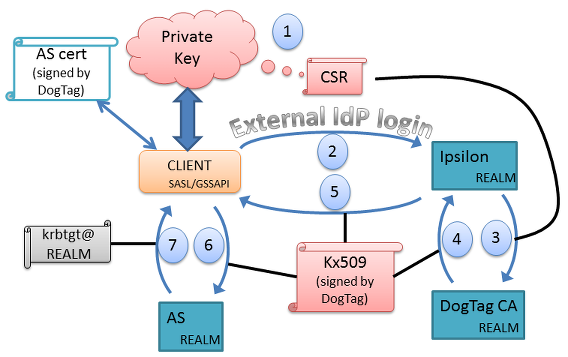
KrbExternalIdPOptionA.png#
In step 1, the client generates a public/private key pair, and a certificate signing request (CSR). The client sends this to Ipsilon in step 2, and authenticates using the procedure specified in either RFC 6595 or RFC 6616 (or by some other means, such as against an LDAP directory). If successful, Ipsilon causes DogTag to sign the client’s CSR, generating a kx509 certificate. This certificate is returned to the user in step 5. The client sends the kx509 certificate to the AS server in step 6 and receives a TGT in step 7. From this point on, the client has access to the services of the realm, and can delete the public/private key pair as well as the kx509 certificate.
Logging in with a browser#
Note that this section relies on the ability to transfer a TGT over http to a browser, which can then store it in the client’s local ticket cache. This functionality does not currently exist.
The following illustration shows an outline of the proposed workflow. In step one, an un-authenticated CLIENT logs into a gateway server configured to authenticate against web IdPs. The proof of identity in this case is that the web-based IdP authenticates the user. The gateway, named “Ipsilon” in the diagram, after the RedHat IdP gateway server, represents the adaptation layer between Kerberos and the web-oriented authentication technology. If Ipsilon is satisfied that the user has been authenticated by a trustworthy web IdP, it requests a TGT from the local realm’s AS on the user’s behalf using the PKINIT mechanism described in Use Case 2. (Step 2) The AS, having been configured to trust the gateway server’s judgement, issues a TGT for the user and returns it. The gateway server then relays the TGT to the client’s browser (step 3). The browser deposits the TGT into the active session’s ticket cache (step 4), making it available for other programs to use (steps 5 and 6).
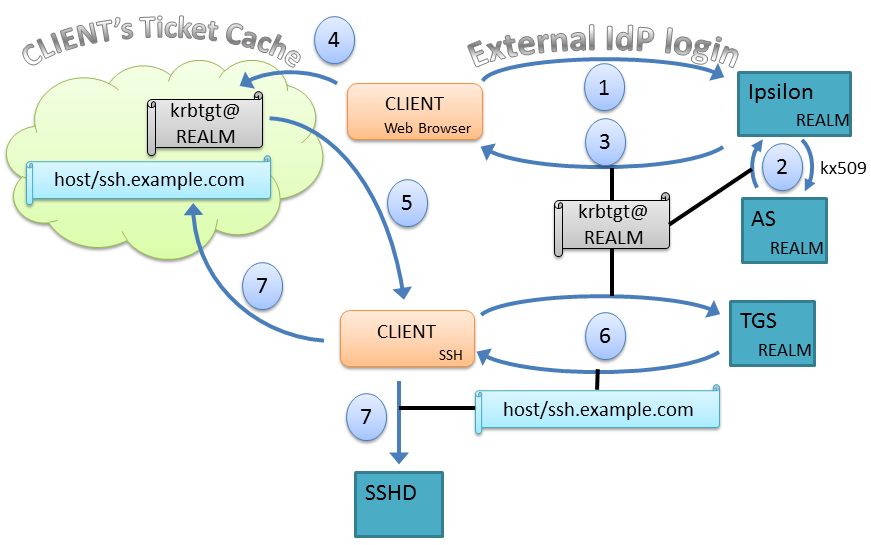
KrbExternalIdP.png#
In order to use PKINIT on the Kerberos side, the gateway server needs to take care of some details. These details are given in the figure below.
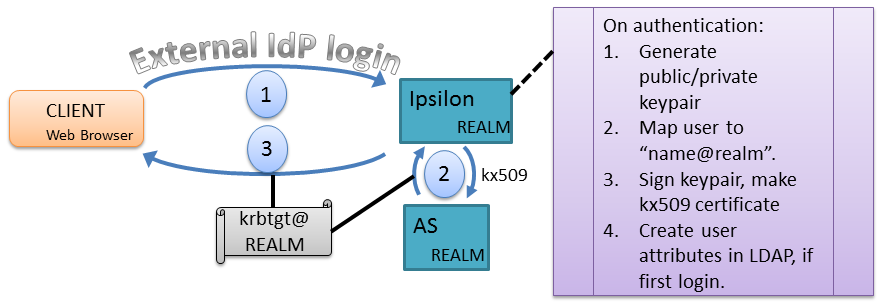
KrbExternalIdPDetail.png#
The gateway server could also permit a browser-based username/password bind against an LDAP directory as step 1 of this workflow. The remainder of the workflow would remain the same.
Design#
Auditing cross realm activity#
The common thread throughout all three use cases is that an actionable audit stream for cross-realm activities must be available. For native Kerberos cross-realm trusts (which includes trusts to AD), the local TGS server must report all usage of cross-realm TGTs. For Kerberos PKINIT, the local AS server must report all PKINIT message exchanges. Implementing support for web-based IdPs as described here uses the Kerberos PKINIT method, and requires no additional audit capabilities.
The existing IPA KDB plugin audits AS exchanges. This needs to be expanded as described here to notice whether the cname and crealm of PKINIT requests already exists in the LDAP store. Likewise, auditing the TGS exchanges must be implemented.
Essential functionality delegated to gateway server#
The IPA server’s cross realm functionality, as proposed in this RFE, deals exclusively with foreign Kerberos principals of the form “name@realm” with optional siphoning of user attribute data from donor realms. This is made possible because non-Kerberos identity technologies are made to appear Kerberos-like by an external gateway server. Functions provided by this server:
Delivery of the TGT to clients over nonstandard pathways (HTTP)
Mapping of non-Kerberos identities to a globally unique, consistent Kerberos-like
cname/crealmpair.Actually interacting with non-Kerberos authentication providers to determine the user’s identity.
Any configuration or shared metadata required to interact with the non-Kerberos authentication providers.
To be clear, this is essential functionality for Use Case 3 only. Use Cases one and two do not require this.
